I am one of those lucky guys whose job happen to frequently offer chances to get to see things you wouldn´t necessarily be able to pull off otherwise. Such as seeing boats you only see in the yachting magazines or on social media. This is because I have to travel a lot. This time I spent a whole week at the Atlantic Ocean as I´ve had an appointment with owners of an Oceanis 51.1 to show them the yard and one another with catamaran owners (LINK) for which I did the same. Lucky me, again: One day in between these appointments, a Wednesday, was without any commitments so I sat myself in the car and drove northwards.

Passing the inspiring St. Nazaire bridge it took me one hour driving more to reach my destination: Lorient. This Brittany city is located a bit south of Brest and – next to Les Sables d´Olonne – may be called the beating heart of French sailing. It may well be most important city of sailboat racing in the world. This is because of “La Base” – the former German U-Boat base happened to be the largest complex of awe-inspiring concrete bunkers and as these behemoths cannot be dismantled, the French continue to use them as the base. This time not for submarines but for the Crème de la Crème of professional racing boats: The Imoca fleet.
Two rivals
Word spread over social media that week about German Imoca-racer Boris Herrmann to having launched his brand new Imoca 60 racing yacht, MALIZIA 3. As a German I felt it would be interesting to take a look at this racing machine first hand and hoped for some luck. As his team didn´t answer my inquiry, I decided to give it a try and drove to Lorient. I was lucky: Finding MALIZIA 3 moored at the jetty, I instantly knew that this trip was paying off already.
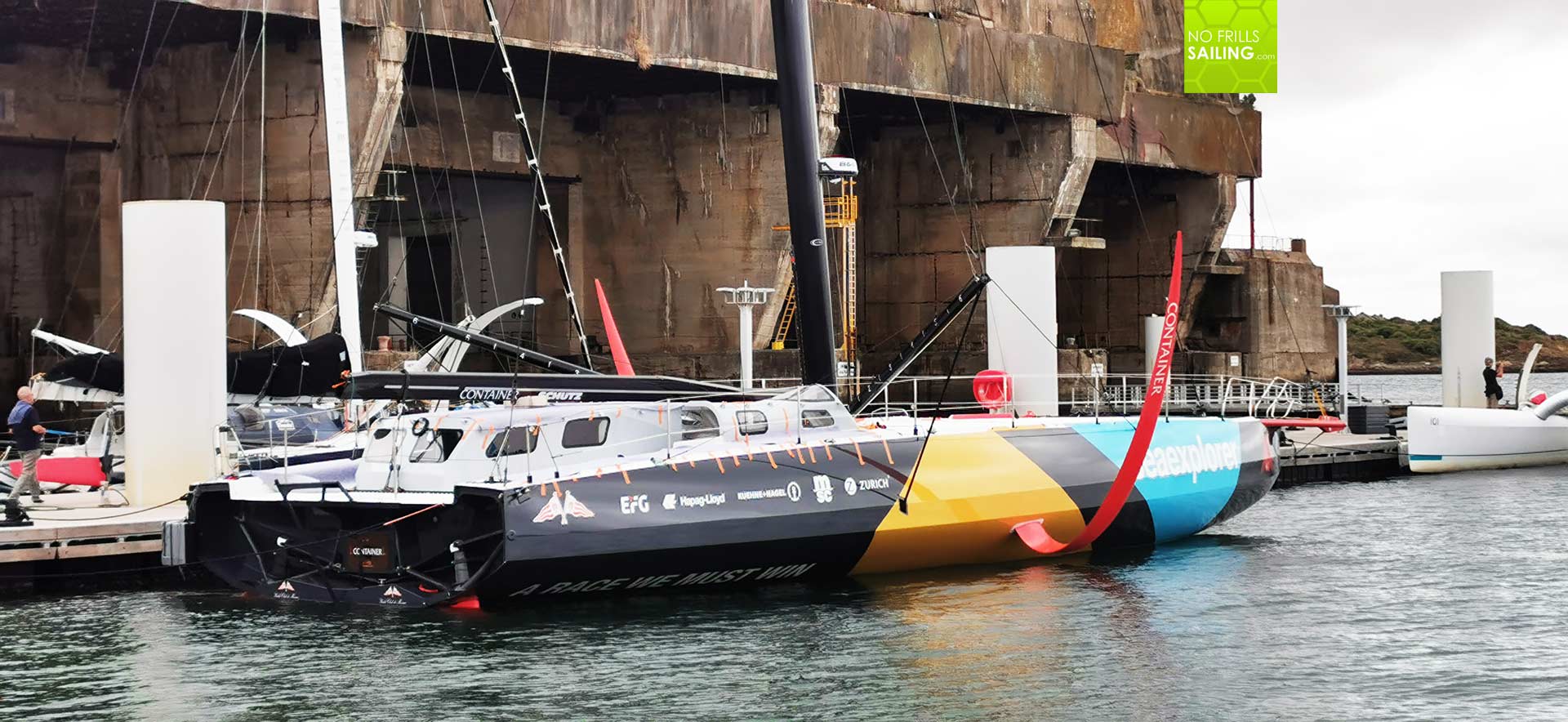
Moreover, “La Base” stayed true to its name and besides brand new German racing boat a fleet of other Imoca 60 racing boats were also tied up at the pontoons. This is the magic of Lorient: You will always find some of the world´s most exciting and capable racing yachts here. To my pleasure one other Imoca also happened to be mooring right there: CHARAL 2, Jeremy Beyou´s brand new racing tool. What a great occasion!
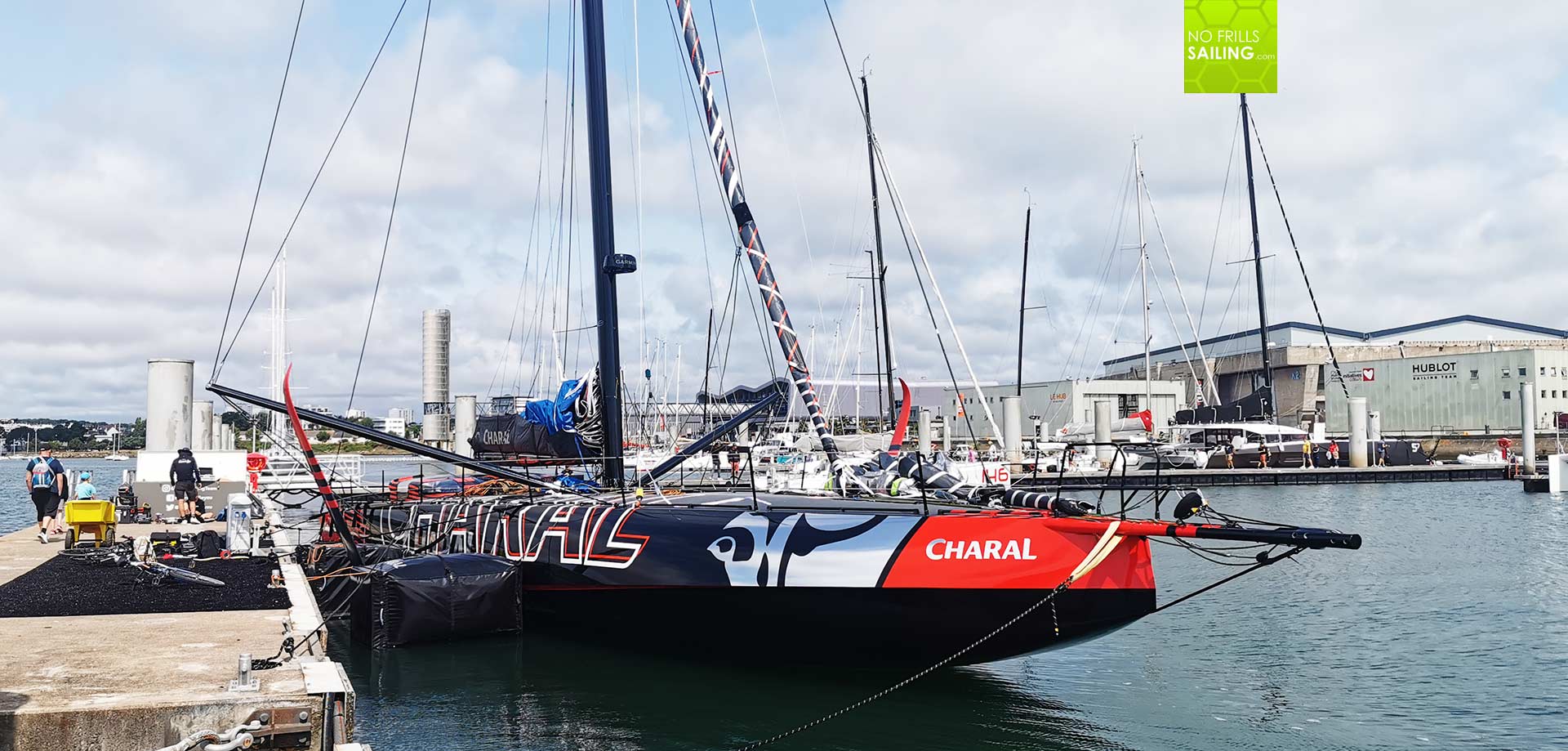
As these two new boats mark the pinnacle of high tech racing boat design, I decided to shoot some details of the yachts and have a side-by-side comparison in order to try to understand the steps taken by the naval architects and engineers to come up with the latest generation of racing boats in their endless struggle to provide the skippers with the latest cutting edge technology to wind the Vendeé Globe, the most prestigious and most important sailboat race of the world.
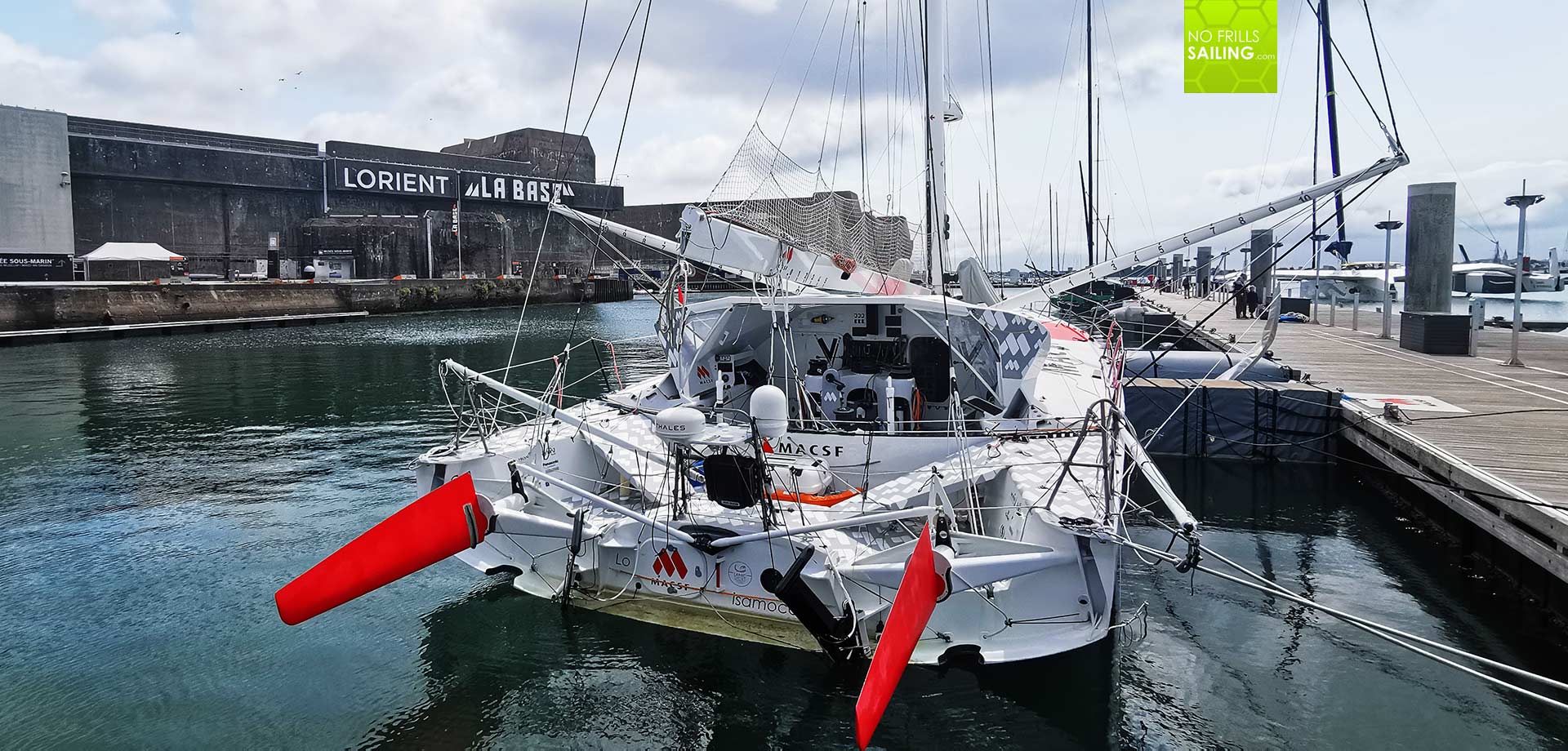
So I decided to have not just a little walk around but to take my time to walk back and forth between those two new boats of which the sailing world is talking all the time. I´d like to discover some of the features, maybe spot changes and getting to explain some of the design changes recently made. Even better than that: Not only the latest generation IMOCAs can be found here at “La Base”, but also their predecessors, older boats dating back to the early 2000s, which make it even more interesting to look at.
The pinnacle of sailing innovation
In this, MALIZIA 3 is said to be the spearhead of naval architecture and boat design. VPLP as the principal naval architects had to tackle various problems and learnings from past Vendeé Globe editions as well to incorporate some special wishes of skipper Boris Herrmann. In general one must understand that Imoca boats have to be designed inside the Imoca class box rule. A set of numbers, maesurements, requirements and restrictions within the boats must be set up. This “box” allows improvements and changes only in a very narrow sense, the aim is to allow for teams without a multimillion budget to compete with older boats as well. Later more on this.
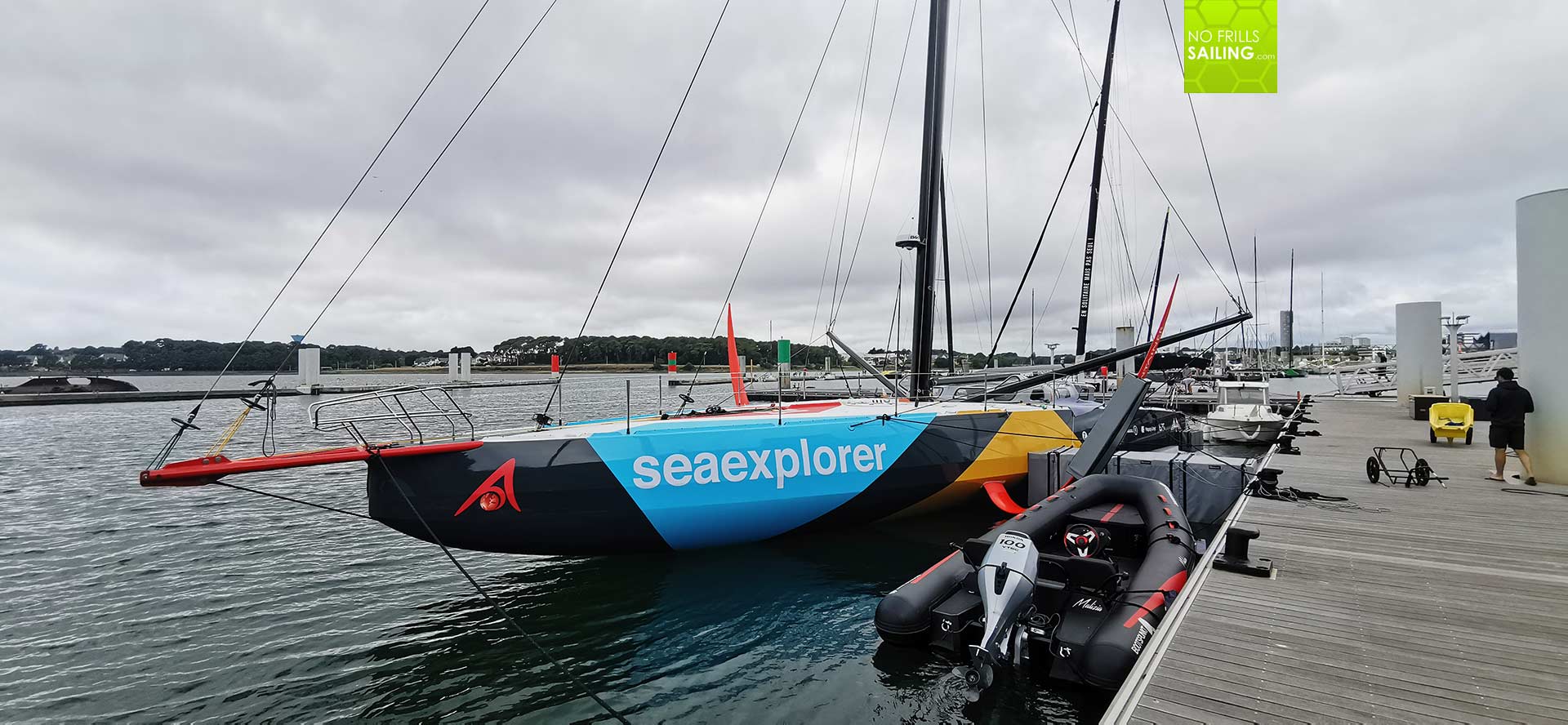
MALIZIA 3 is not a beauty, I shall say first. As much as I love looking at boats, racing boats especially, the one single most and biggest change of this latest generation of racing yachts may technically improve their sailing qualities a lot – but not in an aesthetical. Just like with the latest Pogo 40 S4 Class 40 and seen in recent years in Classe Mini boats, the Imocas now sport a “duckbill”-style bow section. The times of fine entries seem to be over, MALIZIA 3 is the latest of a whole new generation of racers which incorporate this strange looking (I might say ugly) design that is said t be improving sailing abilities especially in rough seas a lot. Let´s have a closer look.
Details: Bow sections of latest generation Imoca boats
Looking at MALIZIA 3 one can clearly see that the stem of the bow is small. The bow itself is very, very voluminous and – watching from above – very wide. The waterline of the bow starts way back abaft, some 3-4 metres before the hull touches water. A duckbill, or, to name it a bit less emotionally, a huge surfboard. Remembering what has happened to Kevin Escouffier in his PRB Imoca during last edition of Vendeé Globe, one understands this approach.
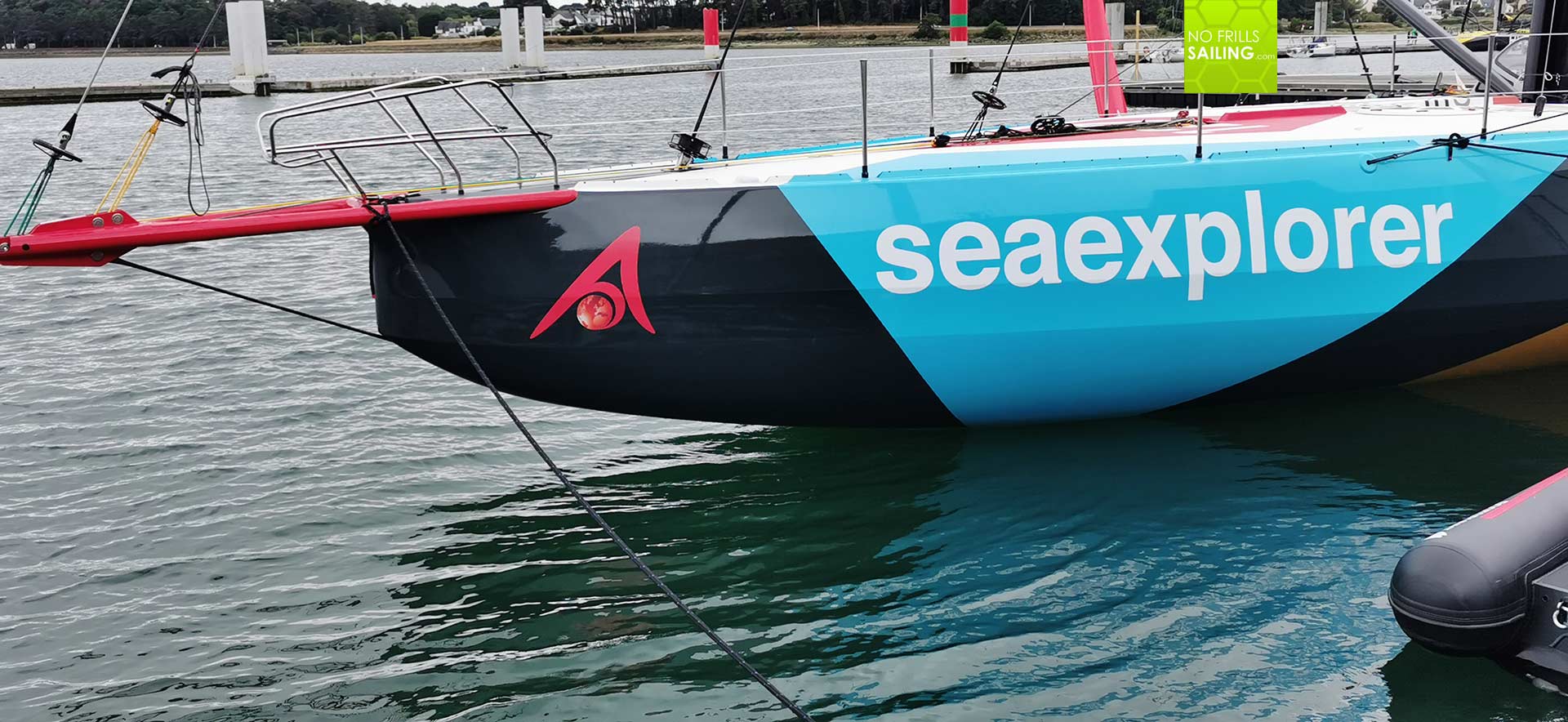
As with ordinary cruising the real enemy of the sailboat is not the wind but the swell. Waves can crush a boat´s neck, waves can and will do the damage. In an Imoca, the worst that can happen is undercutting: The bow pushes itself into a big wave at high speed, like a bullet into a wall. By increasing the volume of the bow and widening the body of the boat, the idea is to prevent undercutting and create much more lift in this section.
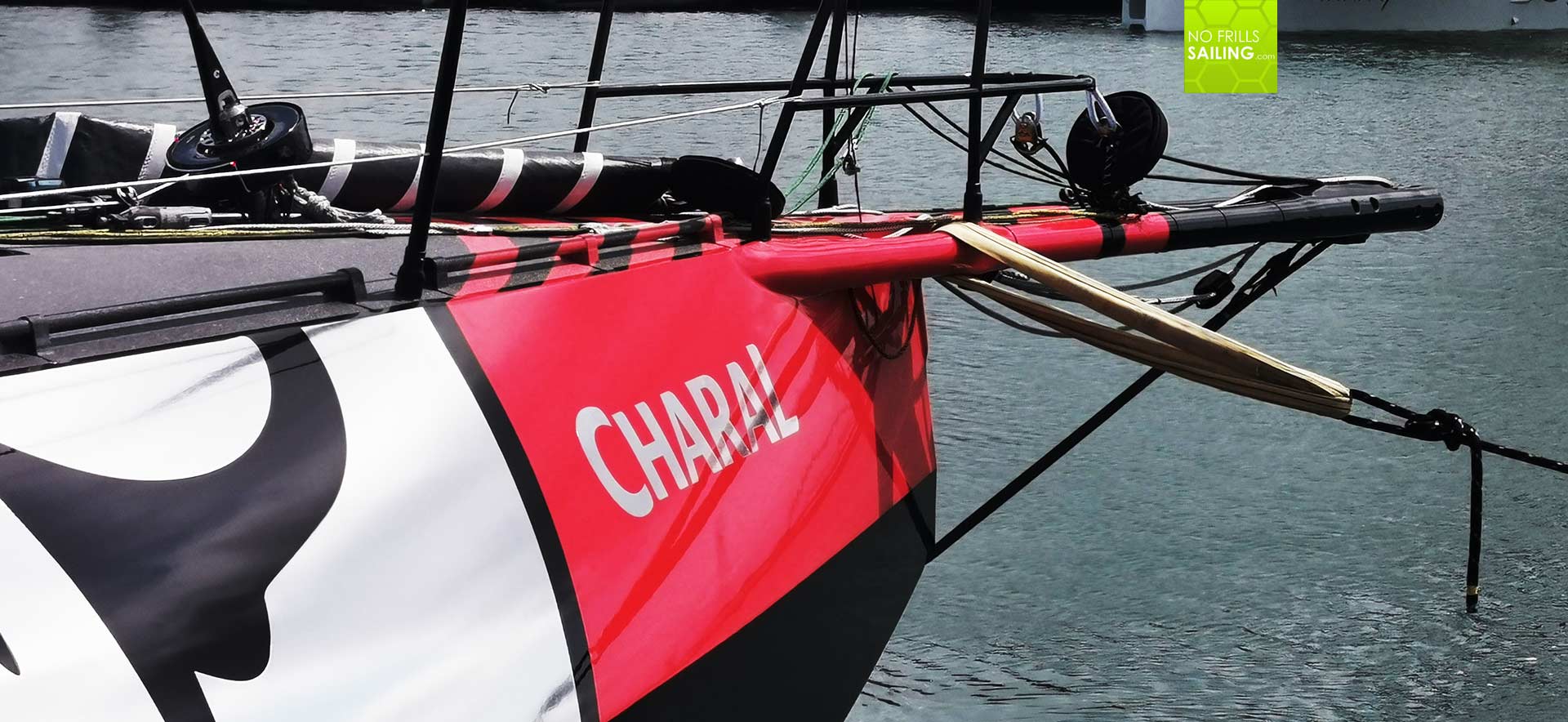
Even in the heaviest seas and on an upwind point of sail, the boat shall now recover itself quickly if hitting a wave straight on was the issue. The horrible snapping of Escouffier´s PRB as seen last year should not be an issue anymore. The same goes for Jeremy Beyou´s CHARAL 2 bow section which is similarly designed: Much more volume here and width. By looking closely you may find a small bulge running from the middle of the vertical part of the stem abaft. A tiny detail, probably to divert at least a bit of the water away from the hull. Interesting, one or two berths in front of CHARAL 2 I notice a very, very familiar Imoca too …

The new boat of Alan Roura´s HUBLOT team bought exHUGO BOSS since Alex Thompson left pro-racing after last year´s disappointing performance by both boat and skipper. HUBLOT was designed and launched in 2019 and was said to be the pinnacle of her time. One can clearly see the difference in bow design: Even her bow section was much more voluptuous back then in 2019 but comparing her to Herrmann´s boat makes her appear even slim. Times are a changin´ …
It´s all about speed: Foils!
Let´s stay with HUBLOT for a second: Take a look at her foils. Again, one can clearly see some development and different approaches here too. With the advent of foiling technology the pro-racing community got a huge boost years ago. Foiling was the new thing and since the box rule of Imoca Class allows at least for main foils, almost all Imoca boats, even the oldest of the fleets, had been retrofitted with those wings, making daggerboards obsolete. HUGO BOSS in 2019 was saild to be the first ever Imoca to having been designed around her foils exclusively.
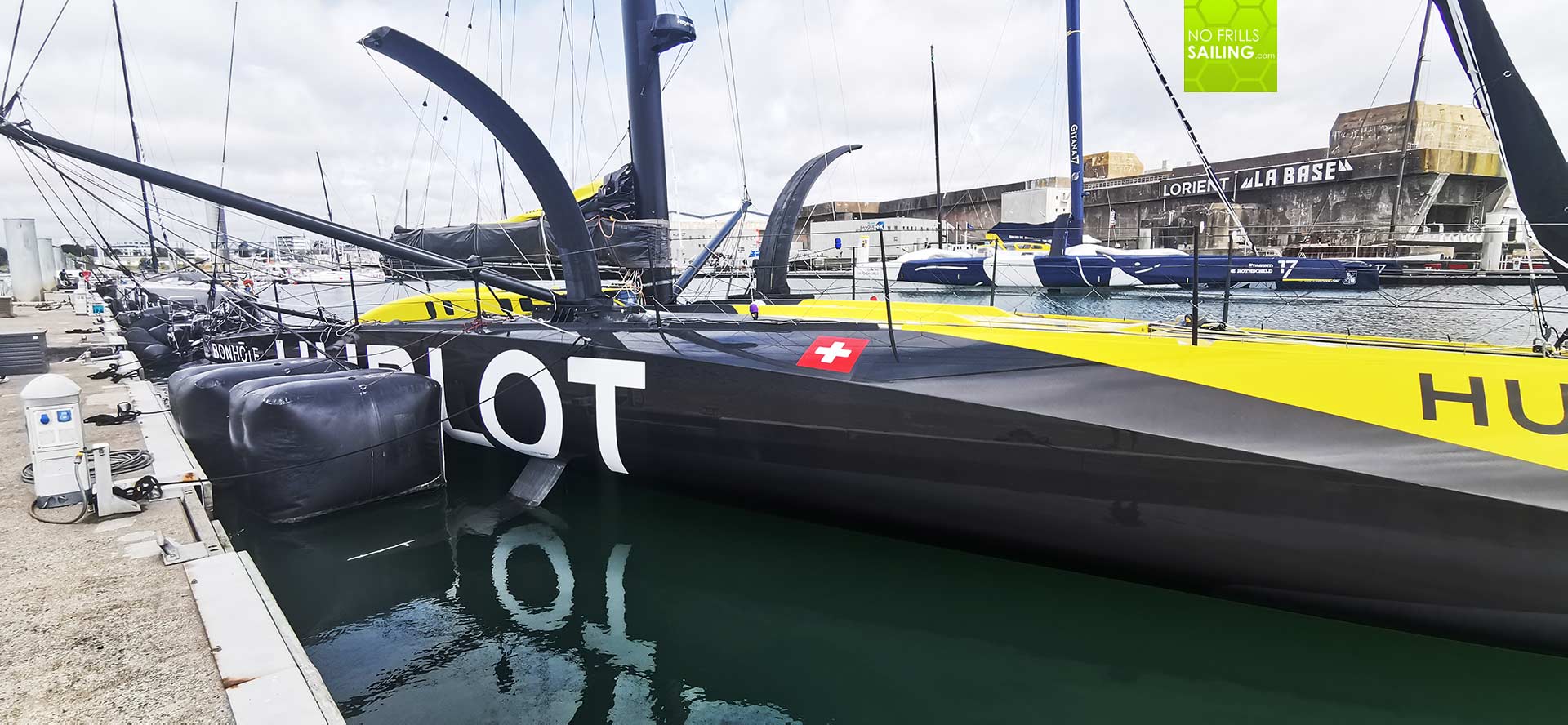
The problem with retrofitting is that the hull itself isn´t designed for foiling. Balance, weight distribution, structural engineering … designers simply tried to calculate where the best position for fitting foils would be and it was more on a basis of a trial and error. Nobody really knew how the boats would behave and would take the constant new strain created by flying and slamming back into the seas at high speeds. HUGO BOSS was said to be different: The first hull to be made to fly. Well, we all know the outcome.
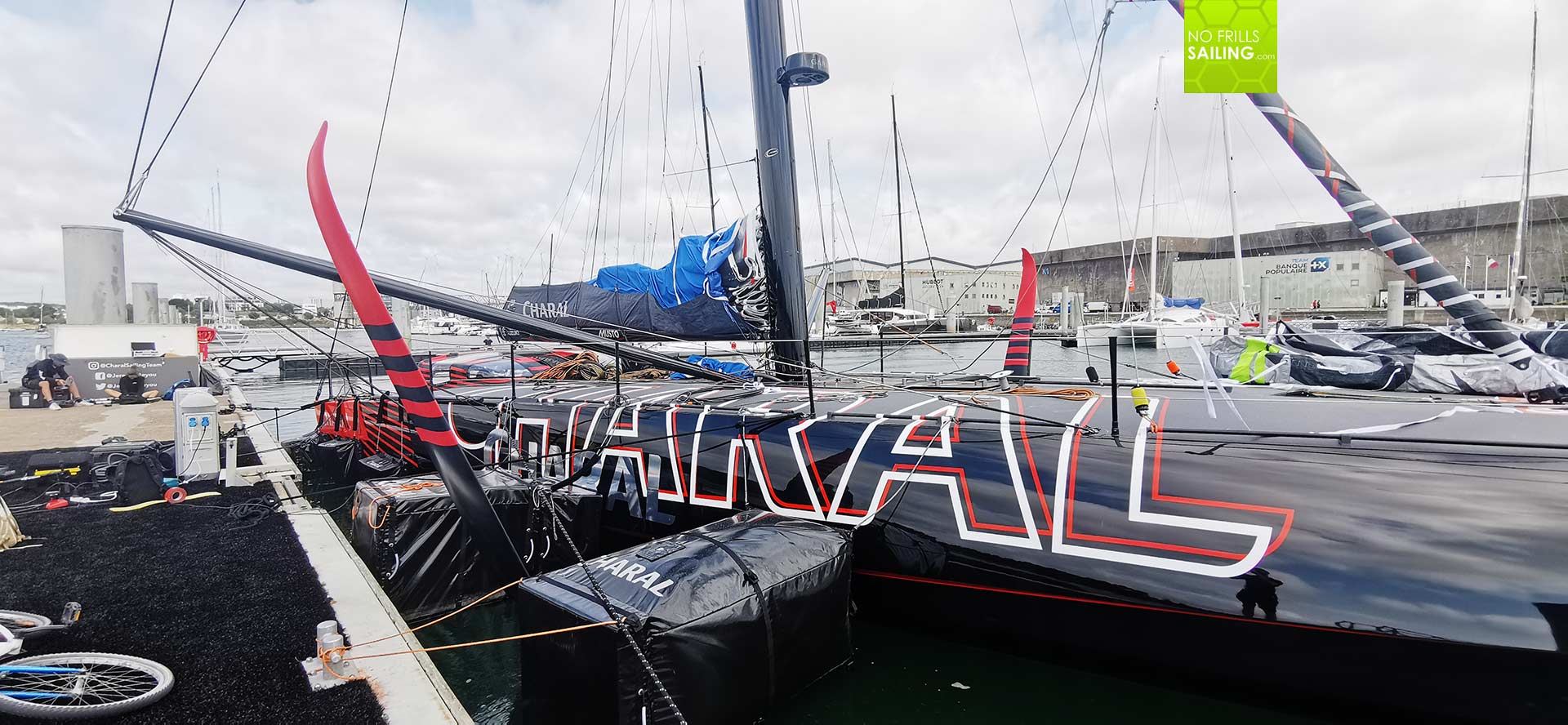
On HUBLOT, the foils are perfectly circular – not so on CHARAL 2: Massive wings which will be extended and lowered down. The idea is to create lift and take out the whole boat of the water and have her gliding above the surface. Why? Because when the hull is out of the water, much less surface has to overcome drag of the medium. Less drag means less energy wasted – much more energy left to push the boat forward. This simply equals more speed. And speed is the key to winning a race. So here I stand, next to CHARAL 2 and touch the composite foils: They appear to be slim and fragile, in reality they are thicker than my thigh, made of high tech composite materials and one of those may cost more than five of my own boats!

MALIZIA 3 has slightly different wings. It is said that her foils can be lowered down much deeper into the sea. The idea is to have the boat out of the water at much lower speeds. I´ve read that MALIZIA should be able to go to foiling mode 3 knots earlier than her counterparts. Meaning, if Herrmann can take off at 13 knots boat speed and start to accelerate to flying-speeds, other will have to wait until they clock in at 16 or more knots before they can take off. A clear advantage. Also, deeper foils should allow for full flying mode in larger waves – another advantage down in the notorious Southern Ocean.
Details: Seamanship and steering
Imagining yourself sailing these monsters is a very exciting thought experiment. The slamming of the boats, the groaning of the material, roaring and screeching noises of the stormy winds outside and the loud banging lie cannon fire when the hull crashes back onto a fiery ocean that is as hard as concrete – day and night, for weeks and months. Alone, a ship without any comforts, wearing a crash helmet all day, holding onto grab handles with both hands as any second a huge wave could crash into the boat, knock you off of your feet and throw you around. Smashing your skull with ease, cracking bones like paper. Well, and exciting thought experiment.

Looking at the doghouse of MALITIA 3, which by the way although certainly most practical, I found heavily ugly designed, I do not fancy being locked here inside for 60 or 70 days, racing around the planet, yet not being able to see anything. As if you could see anything in a boat that travels with 30 or 40 knots through the most violent weather systems on this earth. MALIZIA 3 has an elongated, narrow aft-facing fully enclosed dog house inside which I reckon are most of the mainsheet trimming lines situated.
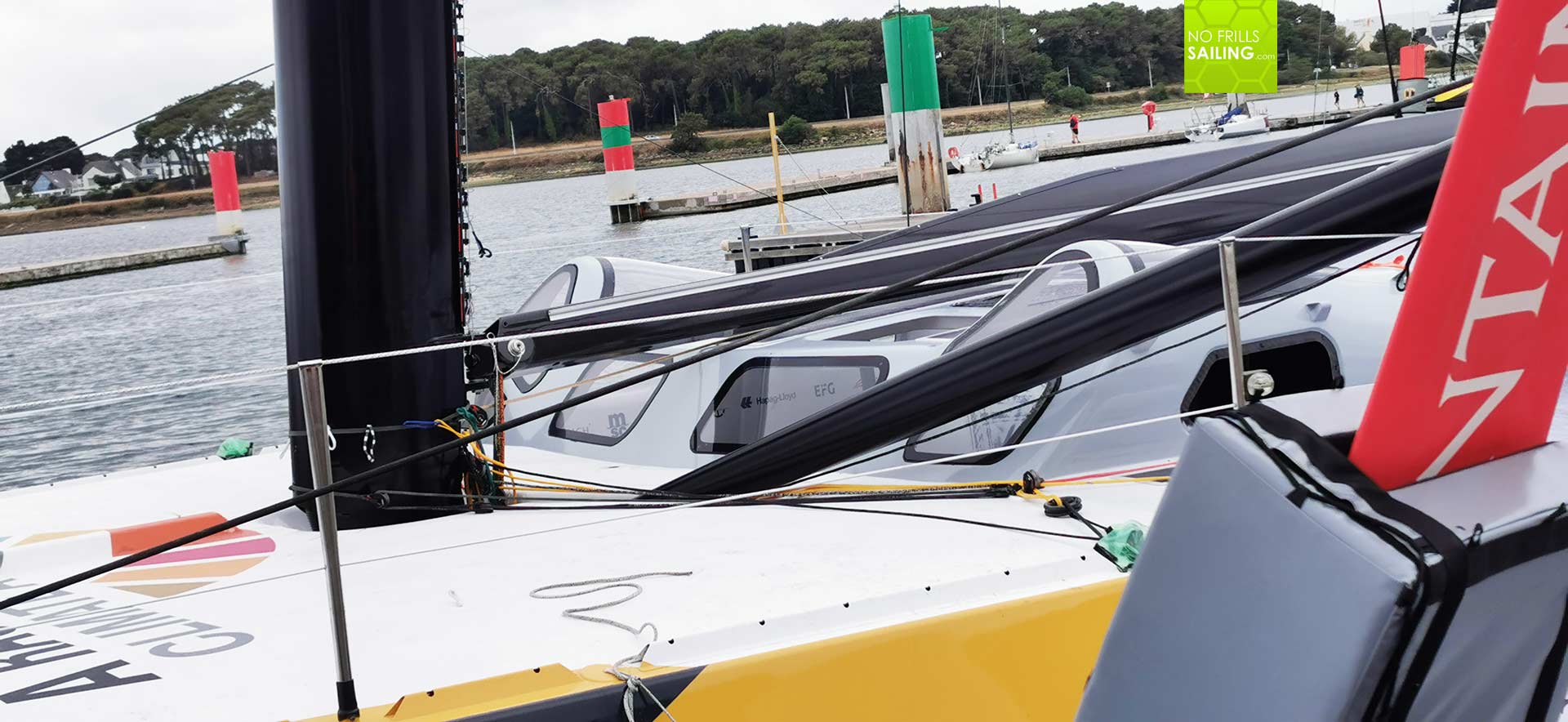
MALIZIA 3´s inners are entered through very narrow openings (where I haven´t seen any doors) to either sides of the doghose and in which Boris Herrmann will find forward facing the central grinder and the winches. It is said that the racing boat features a total of more than 50 lines which form the keyboard of the running rigging – impressive!
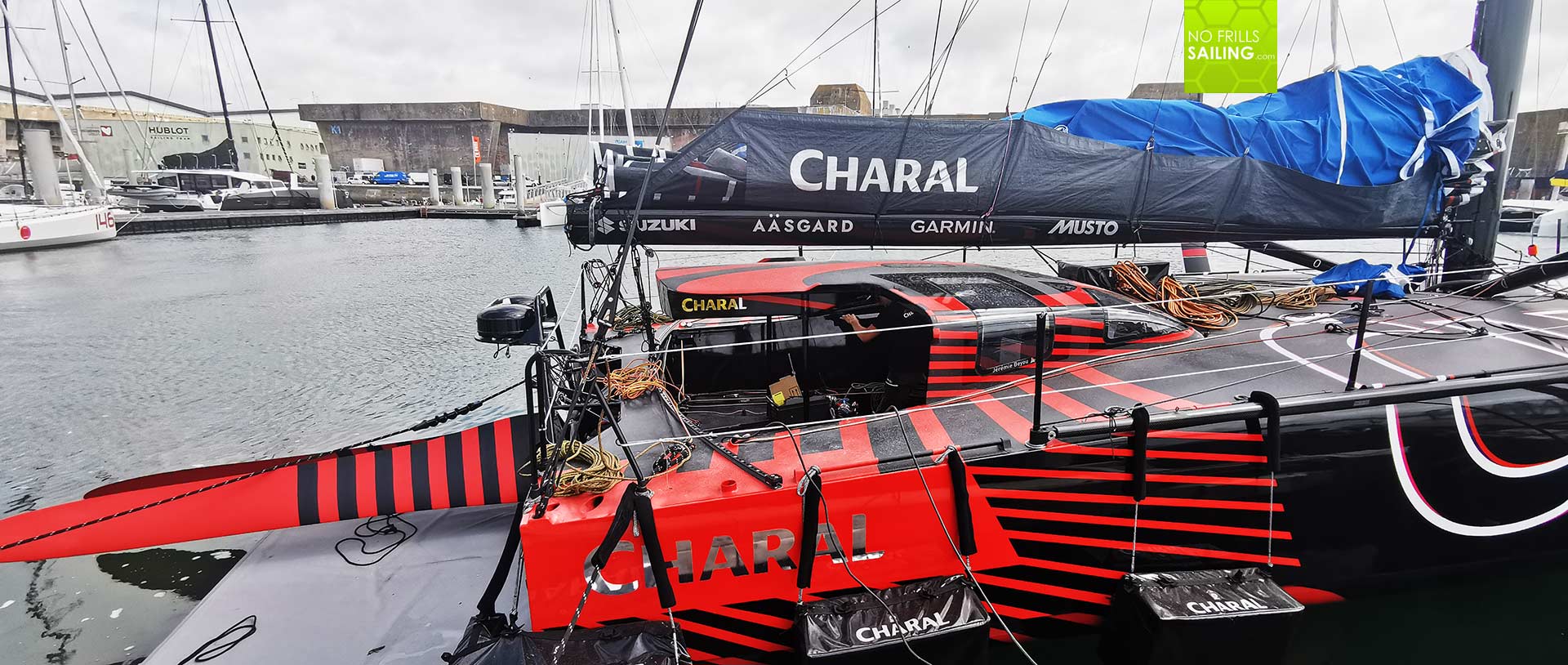
Looking at MALIZIA´s doghose front I can notice two plexiglass (or whatever material they are made of) domes which are streamlined into the carbon fiber construction. These allow for a nice 360 degree roundsight for the skipper. Other than exHUGO BOSS, now HUBLOT, where there virtually isn´t any doghouse-superstructure and the boat is essentially a closed hull, MALIZIA 3 won´t need a sophisticated camera-system to allow showing what´s going on outside. Boris Herrmann will be able to see where he is going to steer hs boat to with his own eyes.

In fact, standing right next to HUBLOT I kind of pity the skipper of this one: Although this great boat looks – my personal opinion – way better that MALIZIA, working inside this racing monster appears to be a nightmare. I´d even prefer the cramped inside of the ugly doghose of Boris´ new racer over that one.
Like the legs of a Fly: New Rudder configurations
Like with MALIZIA 3, the new CHARAL 2, constructed by Samuel Manuard, is a carbon monster and is said to display the latest knowledge in material, construction, structural design, foiling technology and hull design. Manuard is said to be among the most prolific and ingenious racing boat designers today and I can say with some pride that he was the man who made my own GEKKO, a true Manuard. Well, GEKKO is lightyears away from what this man came up with for skipper Jeremy Beyou, of course.

One detail of this latest generation of IMOCA racing boats I found particularly interesting: The rudders. Whilst MALIZIA 3 had hers detached and down in the water, I found CHARAL 2 displaying them in “up”-position. Like the feet of some skinny fly, the rudder blades are folded up at the center line of the boat. MALIZIA 3 can have her rudder blades fold up even hight. Why so? The average speed of an IMOCA 60 racer during Vendeé Globe is 18 to 22 knots. Average weather conditions in the Southern Atlantic … you can imagine quite well. Now, hitting a floating object at those speeds can severely damage your appendages – Jeremy Beyou can tell you more of this, as hitting an UFO with one of his foils did take him out of the competition for a leader´s position in last edition of Vendeé Globe. Now, if an object hit your rudder blade, with the new boats, you can retrieve them high up, sail on the tack of the intact blade and since the damaged blade is in center line – not at the extreme outside of the hull – it will be much easier to repair or exchange with a spare blade.
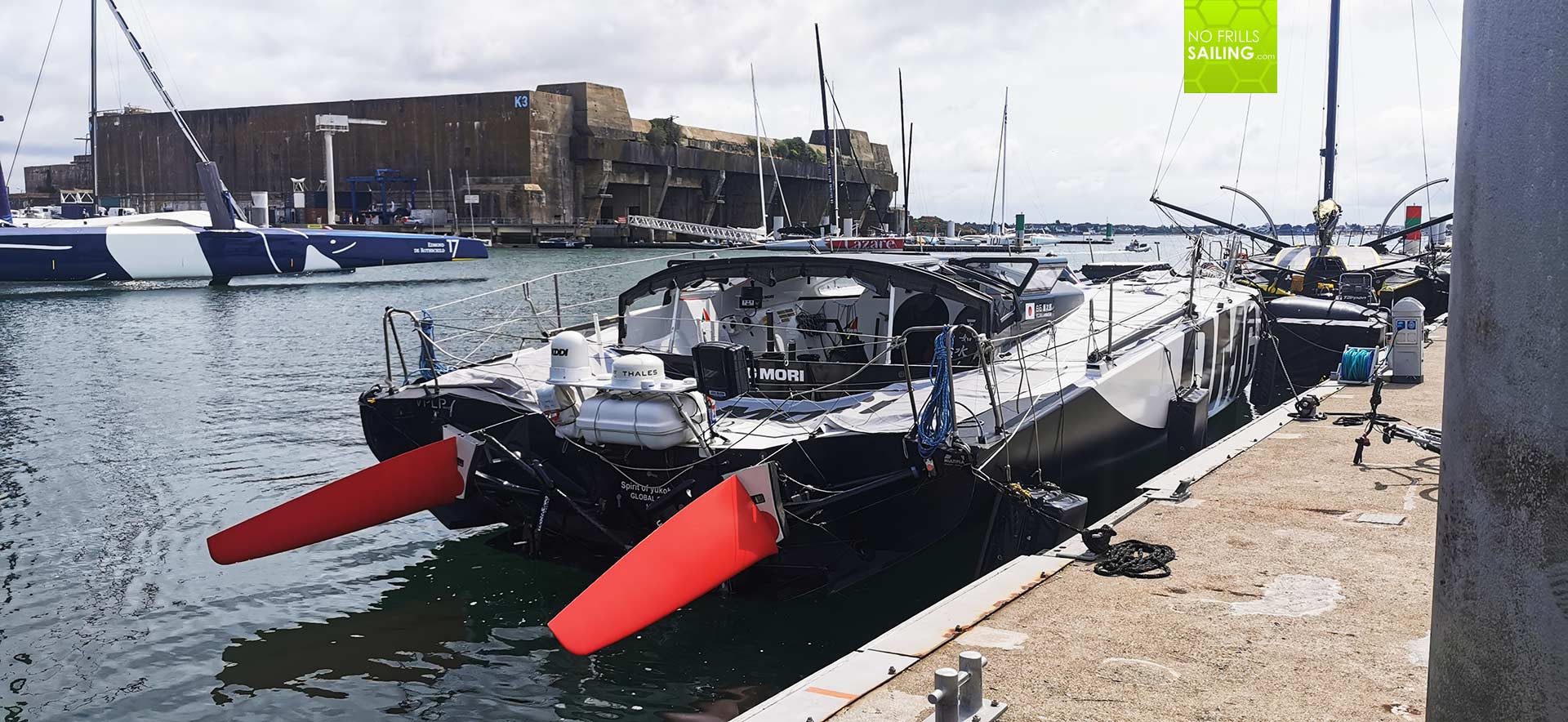
You can easily spot the difference when looking at DMG MORI, the sistership of Beyou´s CHARAL 1. Both rudder blades are much more located to the outside of the hull. While I love the CHARAL 1/DMG MORI design of last year´s Vendeé Globe, I appreciate that Beyou retained a more open approach for his doghouse even in his new design. He will feel the wind and be much closer, much more connected to the elements. Which, of course, can be a curse and blessing at once.
Always worth a visit: “La Base” in Lorient
I could spend hours walking the pontoons of Lorient´s “La Base” and there is certainly so much more to see here: For example, one of the Ultim-Trimarans, GITANA of Edmod de Rothschild, is moored here, so near that you could touch her. I also see one of my most favourite Class 40 designs, a Pogo 40 S3, hull #146 KIHO, a Finot-Conq design of 2015. I don´t fancy much the duck-style S4 by Pogo as the S3 is a wonderfully balanced and aesthetical boat.
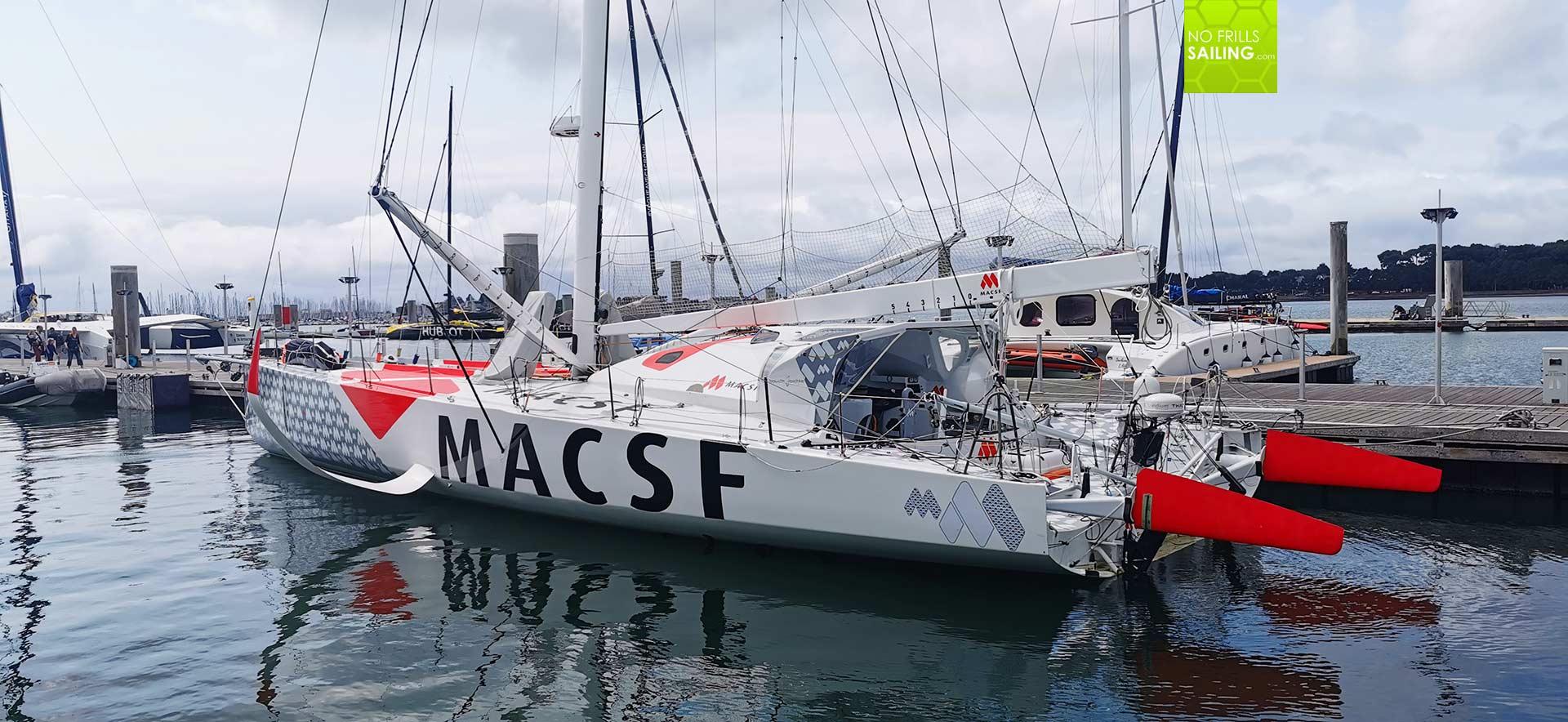
One of the old IMOCA 60 “veterans”, SAFRAN, built in 2007 and skippered by Isabelle Joschke, seems like being from the past: The wide open cockpit appears like posting a safety issue when you come back from looking at those streamlined, sleek and closed off latest generation yachts, the retrofitted foils kind of redicule the old-school fine entry and sharp bow section. Joschke had to abandon Vendeé Globe last year too and it will be exciting to see how she performs against those high-tech warriors of the guys.
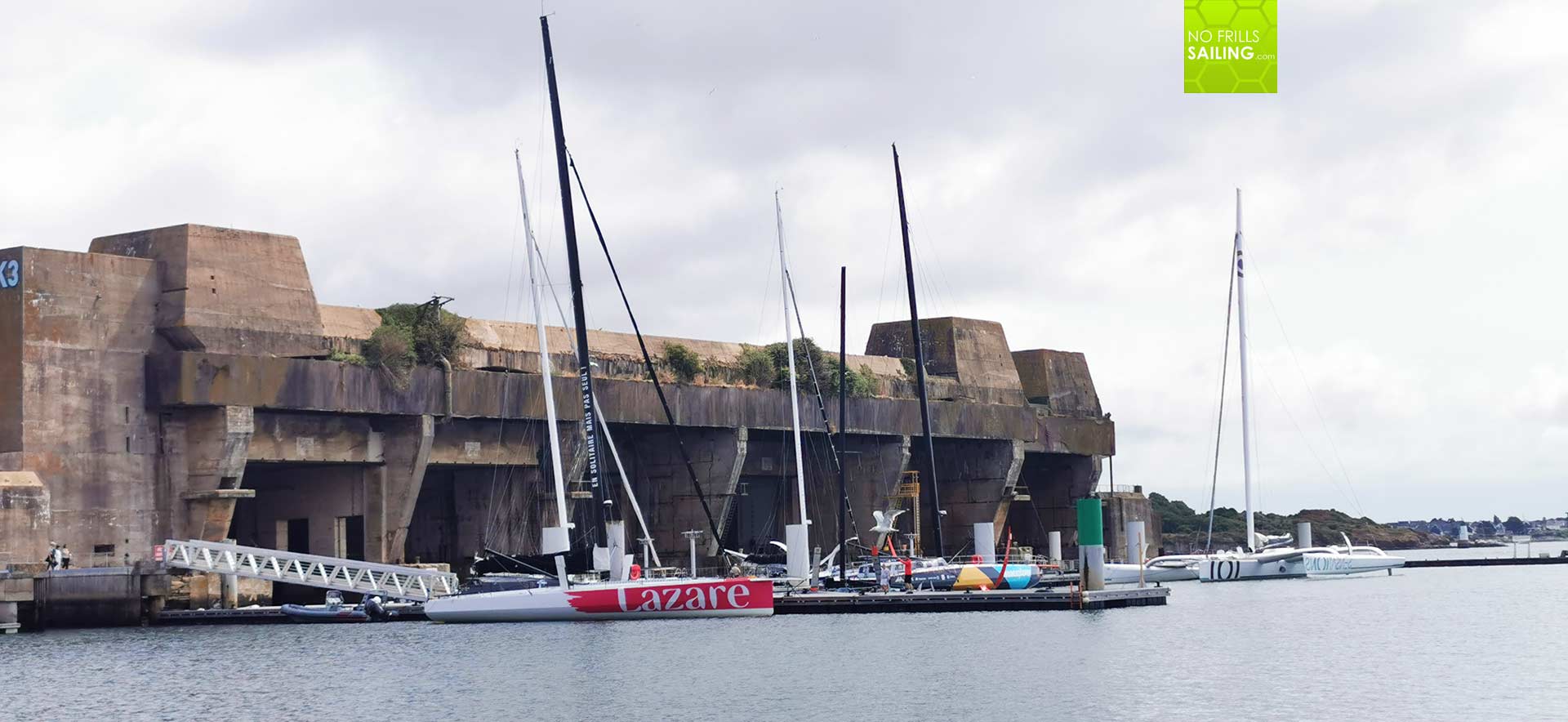
With some sadness I walk back to my car as it was time to leave again. Exciting and absolutely uplifting, “La Base” is such a rich source for material. And it every time again amazes me that nothing is closed off: No fences, no guards, no perimeters and even no entry fee. Walking back to the parking lot (again, no parking fees!) I even could peek through an open door into the workshop of INITIATIVE COEUR, where it wouldn´t have been a problem to stand and watch the guys working. Unbelievable – and unthinkable for, let´s say, the Formula One pit lane, which, as an analogy, comes closest to “La Base”. So, again – if you happen to be in France and love sailing: Come here! It´s where the magic starts.
You may also be interested in reading these articles:
Jeremy Beyou on his (first gen) CHARAL racer
At Multiplast in Vannes
Skipper training for solo sailing an IMOCA 60
